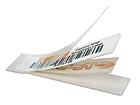Barbarians at the Gates

RFID windshield tags deliver long read range at lower cost for customers automating vehicle access control to gated communities, secured parking and other areas.
Enterprises that own or operate gated communities continue to seek higher level access security but with convenience appreciated by homeowners. It’s a balance that makes sense to the business and the residents.
Residential gated communities are growing in popularity. About six percent of Americans live in a gated community and construction of such communities comprises ten percent of the new home market, and as much as 50 percent in larger metropolitan areas in southern states.
The overwhelming reason people are purchasing homes in gated communities is the sense of security – limiting the volume of traffic in a neighborhood and controlling who has access to the streets.
But managing access to these communities presents many challenges.
Entry to a gated community is typically a manual process – burdensome and subject to errors ranging from forgotten passcodes and lost “clickers” to the outright transfer of access credentials. Manual processes also often choke main entrances with traffic during peak travel times.
“Our clickers were permitting problems at our gates,” said Bonnie Carlisle, president of Southwest Management Services, a community association management company serving large, gated communities in Texas. “We couldn’t track vehicle exits, which hindered forensics after a theft or other incident. And people were programming other cars’ garage door openers to send the clicker signal.”
Traffic management can be cumbersome, too; controlling who – among the contractors, domestic help and other visitors – is allowed requires significant resources.
“Entrance guards get overwhelmed with information,” said Carlisle. “They have guest lists and contractors and new residents to track. On paper, it gets very disorganized.”
Avoiding errors and controlling cost – truly enforcing who can access the community without incurring heavy staff and infrastructure expenses – is important to fulfilling the promise of residential gated community life and meeting business goals.
It was this value proposition that brought Austin, Tex.-based Radiant RFID and GateSource Corporation together to develop a modern, passive solution for Southwest Management. GateSource offers a Web-based application that provides immediate and precise data exchange between security guards, property owners and administrators – “self-service” software for all users throughout the community. It eliminated the security staff’s administrative burden of logging and updating resident information – the relationships between properties, occupants, guests, vehicles and gate credentials. But GateSource was relying on old “clicker” technology for gate authentication, opening exposure to the aforementioned access control challenges.
“The Web-based application fixed many problems for us,” said Carlisle. “But RFID was the missing link.” Radiant RFID brought its expertise in RFID integration to bear, connecting the data on the backend of the GateSource software to an RFID-controlled system for points of community entry. The system communicates via Web services to validate tags and assign rules to readers and gates.

Businesses that own or manage gated communities, a fast-growing housing sector, see advantages in providing a balance or higher security and convenience to homeowners.
“The tags have to hold up to the Texas heat,” said Ratton. “Temperatures inside cars parked outside are outrageous in the summer.” He turned to Metalcraft for help with engineering an RFID tag that would fit the requirements for gated communities. Said Aaron Hobart of Metalcraft, “Our engineers tested many different inlay samples and substrates to come up with just the right combination.” It sandwiched Gen2 inlays between thin layers of polyester, adding human readable printing to one side and a windshield-compatible adhesive to the other.
The RFID-controlled community access solution has demonstrated many of the expected benefits.
First and foremost, the system delivers precise tracking and control of community access. Each tag issued is specific to a vehicle, and the data captured at the gate creates a detailed access log, updated on the web-based application every 10 minutes, enabling nearly real-time, sortable information.
“RFID technology provides increased security,” said Carlisle. “There is no ambiguity about who is accessing these communities.” The access log is useful for forensics, too, especially when tied to video. “One of the big costs for a gated community is damage to the gates,” said Ratton. “But the system allows managers and law enforcement to use the access log information as evidence in the event of a crime like vandalism.”
Secondly, the online administration saves time for managers and residents. Even issuing and activating tags is done through the GateSource online software. Carlisle’s guards can then affix a tag at a gate or can mail it to the approved user.
Finally, residents of these gated communities take satisfaction in knowing access is controlled with a system that is easy to use.
“Our residents just love the new RFID system,” said Carlisle. “I can’t tell you how many e-mails I’ve gotten telling me it’s great.” On top of these benefits, the solution is roughly half the cost of traditional “clicker” access systems, speeding the way to a healthy return on the investment for gated communities.
SIDEBAR: Elements of Gate Operators
To secure areas of a property where authorized vehicles need to gain access, security gate operators and entry control systems are essential elements.The three most critical, according to Randy Baker of Linear/Osco are “the weight of the gate, its length and the duty cycle — or how many times it will be used in a day.” Baker said one of the most common installation errors he sees is the use of a light-duty gate operator for a high-duty cycle application.
Also consider the class of device required when selecting a gate operator. There are four classes of gate operators. Class 1 and 2 are residential and commercial. Class 3 is limited access and Class 4 is restricted access. Limited access systems are designed for industrial locations such as loading docks that don’t serve the general public. Restricted access equipment is used in airport security areas or prisons and is typically operated by security personnel.
When selecting a telephone entry system, a key decision is whether to run a wire to the guardhouse or security office or whether to select a system that works with the public telephone network. The second choice can simplify installation significantly in some situations.
Although some entry control systems are stand-alone, others may be part of a larger access control system. Some of these are identical to proximity card readers or wireless keyfobs that might be used in pedestrian systems.
Although systems based on in-car transmitters tend to be more costly than pedestrian-style systems, the upside is that they provide an extra level of convenience by allowing authorized vehicles to simply drive up to the entry control point and automatically gain entrance. Some such transmitters are attached to a car’s license plate holder and communicate with a loop installed underneath the pavement, while others attach to a car’s front window and broadcast to a reader installed at the entry point.
Looking for a reprint of this article?
From high-res PDFs to custom plaques, order your copy today!





